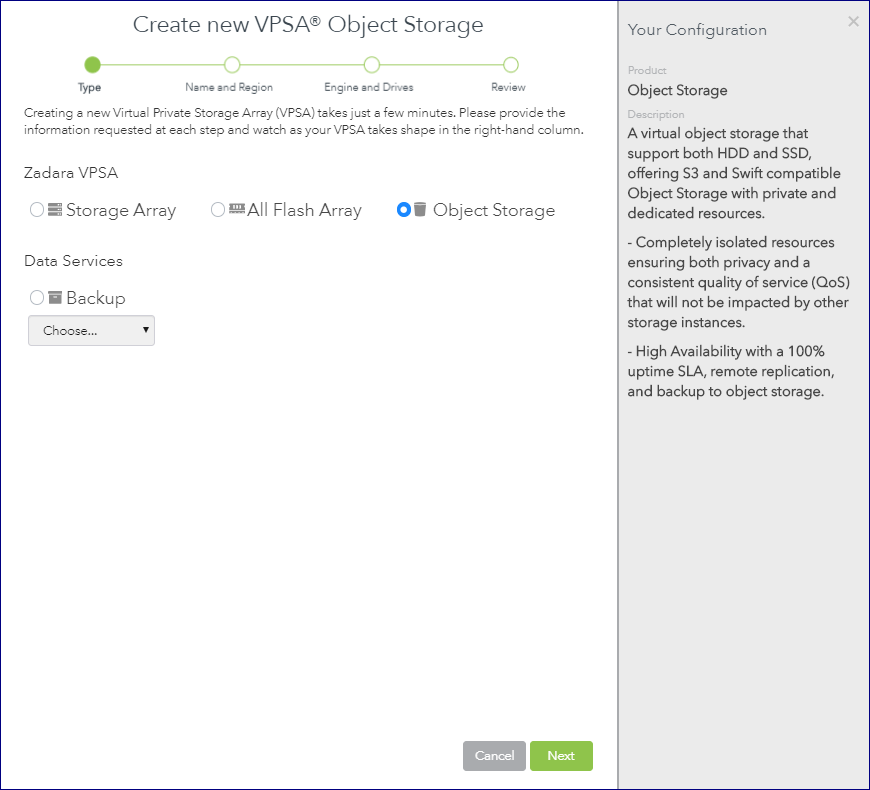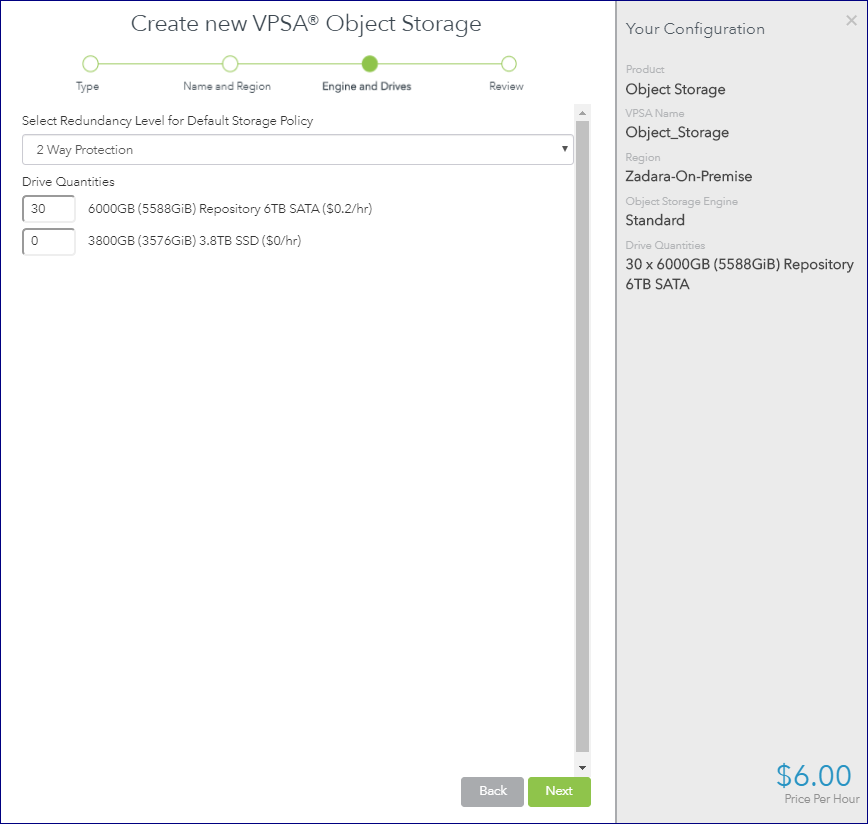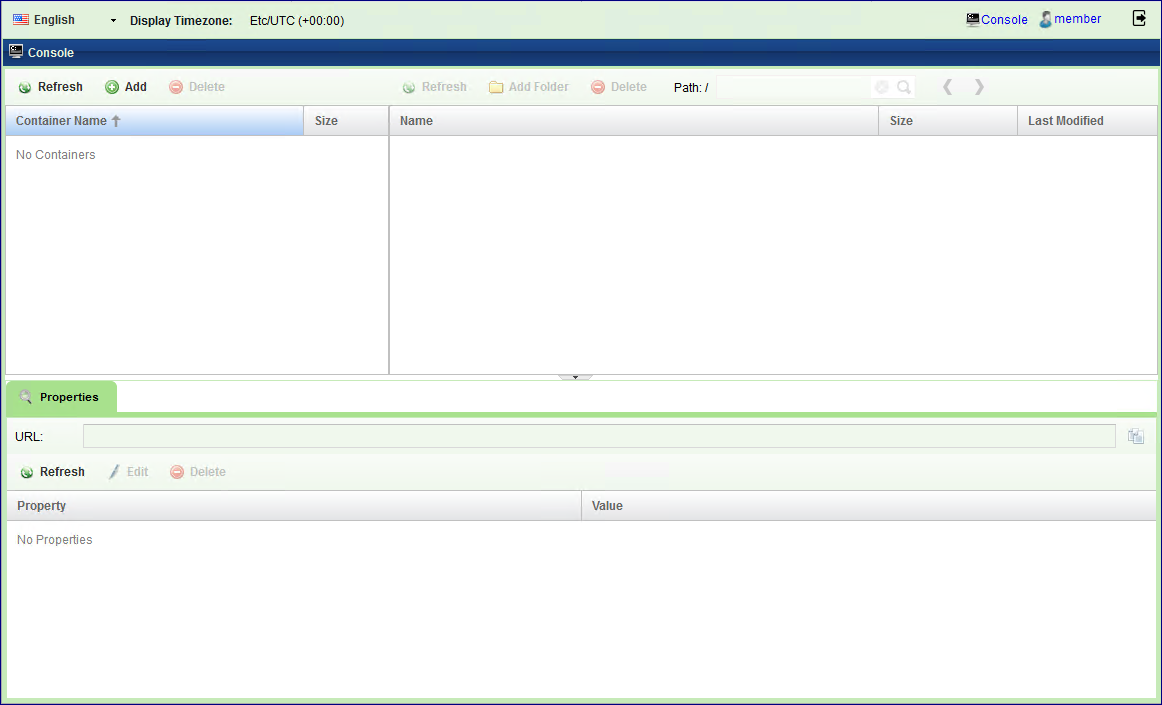Getting Started¶
This chapter contains step-by-step instructions to both create a VPSA Object Storage and then to configure its storage properties
Registering a Zadara Account & Creating a VPSA Object Storage¶
Go to https://manage.zadarastorage.com/register/ and complete the registration form to create a new Zadara Account.
Go to your Zadara Provisioning Portal at https://manage.zadarastorage.com, or at your private cloud, using your username/email & password, and press Create Zadara Storage VPSA
In the creation wizard select Storage Array, Flash Optimized or Object Storage. VPSA Storage Array and Flash Optimized creation are described in the VPSA Storage Array User Guide.

Note
This example uses the Zadara Storage provisioning portal https://manage.zadarstorage.com . In case you have your own Zadara Cloud deployment, replace the example URL with your own URL or IP address of your Provisioning Portal.
If VPSA Object Storage was selected The following screen will be displayed:

Enter the following mandatory fields:
VPSA Name Give the Object Store a name. This is how it will appear in the Cloud Console and in the GUI. If you are planning on having multiple VPSA Object Storage configurations, you might want to give it as detailed a name as possible.
VPSA Description free text description.
Cloud Provider Select the Cloud or Co-lo where your compute instances are hosted.
Object Storage Profile Standard/Premium/Premium Plus For addition information about the VPSA Object Storage profiles, see VPSA Object Storage Profiles
Select a Region Select the Cloud Provider region where you want the system to reside. For best performance the servers using the object storage should be in the same region in order to establish connectivity, however this is not a must. Available Regions depend on which Cloud Provider you select.
High Availability Protection Zone In cloud locations that provide protection zones, select in which zone the new VPSA Object Storage will be built. Zones depend on which Cloud Provider and region you select. Selecting the “Multizone HA” option, will provision the VPSA Object Storage across the two availability zones.
Press Next

Redundancy Level supported
- Single zone VPSA Object Storage
2-Way Protection
Erasure-Coding 2+1 or 4+2 (using 3 Fault Domains), 6+2 or 9+3 (using 4 Fault Domains)
Multizone HA VPSA Object Storage - all the above policies support MZ deployment, please refer to VPSA Object Storage Profiles for additional information and requirements for Object Storage Data policies.
With 2-way it keeps 2 copies of each object. Erasure coding protection is done in 2+1 and 4+2 configuration that requires 50% extra capacity for redundancy. 6+2 or 9+3 configuration requires 33% extra capacity for redundancy.
Drive Quantities Select the type and number of Drives that you would like to allocated to your VPSA Object Storage.
The Zadara Cloud orchestrator allocates dedicated drives.
Drives are allocated from as many different Storage Nodes as possible to provide max redundancy and availability.
The number of drives that can be selected depends on the protection level required.
For 2 way protection, 4 - 24 drives can be added to the system in one operation.
For erasure coding, 3 - 48 drives can be added to the system in one operation.
For 2-way protection an even number of drive must be selected.
For Erasure Coding protection the number of drives must be divisible by the EC redundancy policy (e.g for 4+2 protection, the number of drives must be divisible by 6).
Press Next

Once you have completed selecting the above VPSA characteristics, review the displayed summary. You can click Edit to modify your previous selections. Press the Create button to confirm the VPSA creation request. The requested VPSA Object Storage will appear in the “Awaiting Approval” list.
Completing the VPSA Object Storage creation requires the approval of a Zadara Storage Cloud admin. Once approved, the new system only takes a few minutes to launch. During that time the VPSA Object Storage status will be changes to “Launching”.
Once ready, you’ll receive an email with a temporary password to the registered email address.
The VPSA Object Storage web management interface is accessible using the “Management Address”:

Use your registered username or email address, and the temporary password, to enter the management interface. You will be immediately prompted to set a new password for your ZIOS Admin account. It is recommended to enable MFA (Multi-Factor Authentication) in order to add an additional layer of security to your account.
Congratulations! You have a new VPSA Object Storage provisioned and ready.
The newly created VPSA Object Storage already has a single account named “zios_admin”, and you are the only user defined “admin” with the role of “ZIOS Admin”. You can now manage your VPSA Object Storage - create containers and start uploading and serve objects, or create additional accounts and users for others to use.
The following sections describe in detail the various capabilities and services of your VPSA Object Storage.
Understanding the VPSA Object Storage User Interface¶
- The web management interface changes according to the context of the user that
logs in. The User’s Role determines the actions, available for each specific user.
This is the web management interface as seen by the ZIOS admin account users. It includes:
Dashboard
Resources Management (Drives, Policies, Reports, VPSA Object Storage Console)
System Settings
Accounts Management (Accounts, Users, Roles, Requests)
Logs (Access Log, Event Log)

The VPSA Object Storage web management interface provides full management capabilities and control of your VPSA Object Storage, for ZIOS Admins. It provides full management and control of the Account level to the Account admins. It contains the following main components (as numbered in the above screenshot):
Main Navigation Left Panel – Traverse through the various entities. The selected entity is highlighted.
The Center Pane – Displays a list of objects from the selected entity type (e.g. drives in the above screenshot example), and for each object it displays its main properties.
The South Pane – Displays detailed information regarding the selected object. All objects have at least 2 tabs:
Properties – Detailed properties of the object selected.
Metering – Typically IO workload metering info.
- Related Objects – Lists of other objects related to the
selected object.
Logged-in user – Displayed at the upper right corner. Clicking this link opens the user’s information screen as described under the User Information (Managing Users section).
Selected Language – Displayed at the top right corner. You can use this drop down to change the displayed language. Available display languages are: - English - Japanese - Korean - Deutsche - Portuguese
This is the web management interface as seen by an Account Admin. It includes:
Users Management
VPSA Object Storage Console

- Account Member logged in user will have the VPSA Object Storage Console
view only.
